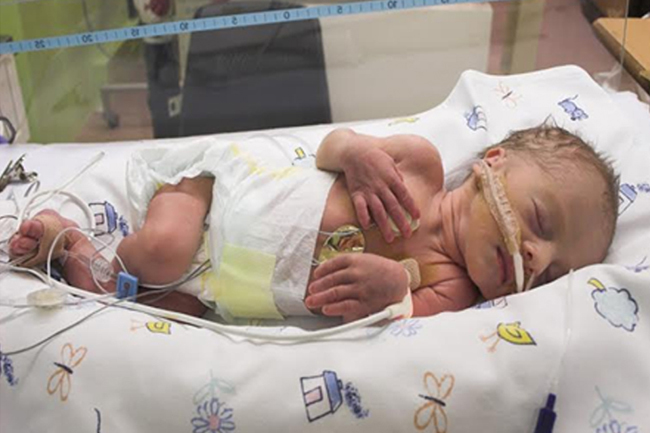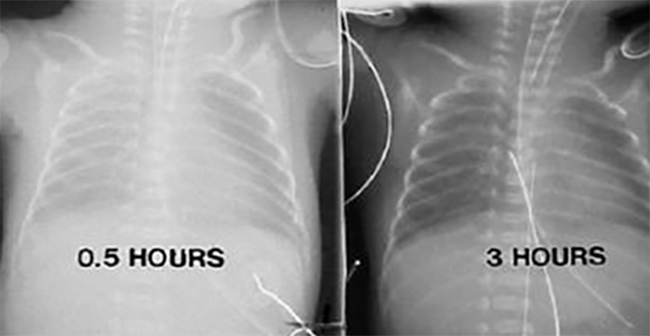Respiratory distress syndrome, also known as Hyaline membrane disease, occurs almost exclusively in premature infants. It is a complication in about 1% pregnancies. Respiratory distress syndrome is the leading cause of death among preterm babies. It is a medical emergency which also affect term babies with birth asphyxia and infants born to diabetic mothers.
The incidence and severity of respiratory distress syndrome are related inversely to the gestational age. Approximately 50% of the neonates born at 26-28 weeks' gestation develop Respiratory distress syndrome, whereas less than 30% of premature neonates born at 30-31 weeks' gestation develop the condition.
Incidence is 42% in infants weighing 501-1500g, 71% in infants weighing 501-750g, 54% in infants weighing 751-1000g, 36% in infants weighing 1001-1250g, and 22% in infants weighing 1251-1500g.

Why is respiratory distress syndrome an emergency in neonatology?
Alveoli are small sacs in the lungs where the gas is exchanged. They are coated with surfactant which is a soap like material which is produced in the lungs of the fetus between the 24th and 28th week of pregnancy. Most of the babies produce enough surfactant by the 34th week of pregnancy. However, in preterm neonates, the lungs do not contain the necessary amount of surfactant, which makes the lungs stiff and unable to open once the neonate is born. This causes difficulty in breathing.
What are the signs and symptoms of Respiratory distress syndrome?
The signs and symptoms are noticed immediately after birth. They include:
- Rapid and shallow breathing,
- Blue coloured lips, fingers, and toes,
- Flaring nostrils,
- A grunting sound when breathing.
How is Respiratory distress syndrome treated and managed?
Treatment is started immediately after delivery. Babies are given respiratory support with continuous positive airway pressure (CPAP) to prevent the alveoli from collapsing. Baby is administered surfactant down the airways, immediately after baby is born or when RDS is diagnosed. Infants who receive surfactant are able to breathe more easily after few hours. Supportive therapies such as the diagnosis and management of patent ducus arteriosis fluid and electrolyte management, trophic feeding and nutrition are given.

Chest radiographs in a premature infant with Respiratory distress syndrome before and after Surfactant treatment. Repeat chest radiograph after surfactant therapy at 3 hours demonstrates marked improvement.
The road to recovery for every newborn is different. Some newborns may require support from ventilator and some may need more oxygen than others. Some also require several doses of surfactant. It is also very important to know that RDS tends to get worse before it starts to get better.
What are the complications of RDS?
Neonatal RDS tends to get worse over the first few days after the baby is born. If not diagnosed and treated on time it can lead to serious complications which can be fatal. Possible complications of RDS include:
- Bleeding in the lungs (Pulmonary hemorrhage)
- Bleeding in the brain (Intraventricular hemorrhage)
- Air buildup in the sac around the lungs(Pneumothorax)
- Blood infection (Septicemia)
- Chronic lung disease(Bronchopulmonary dysplasia)
- Visual impairment (Retinopathy of prematurity (ROP)
- Neurodevelopmental delay, hearing loss (Periventricular leukomalacia)
How is Respiratory distress syndrome prevented?
The major risk factor for respiratory distress syndrome is prematurity. Preventing preterm birth will also prevent RDS. With a good prenatal care, several risk factors that could lead to a preterm birth can be prevented. If delivery is anticipated before 36 weeks of gestation, the mother may be given corticosteroids as a therapy before birth in order to accelerate the maturation of the fetal lungs. Antenatal Consult with Neonatologist will help and guide parents in treatment of their baby.
Parent and Family Support
Parents often undergo much emotional and financial stress with the birth of a critically ill, premature baby with Respiratory distress syndrome. Parents may feel guilty and may be unable to relate to the neonate in the intensive care setting. They may be anxious about their child's prognosis. Parents are well informed by the Neonatologist about the babies condition and procedures involved especially during the acute stage of the disease. They are assisted in frequently visiting, touching, feeding and caring for their baby as soon as possible. Before discharging from the hospital, immunization is given and follow-up care is arranged with a multidisciplinary team and coordinated by the Neonatologist.

Our Women and Child Services in LIFELINE can be utilized for Care during Pregnancy, Antenatal consult with Neonatologist, Safe delivery and Postnatal care of the baby. NICU services are available (Tel: 04-8845666).